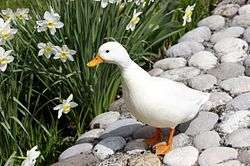Call duck

The Call Duck is a bantam breed of domesticated duck raised primarily for decoration or as pets. Call ducks look similar to some other duck breeds, but are smaller in size. Call ducks were initially used in hunting, where their own calls and quacks would attract wild ducks towards the hunter's guns. This practice has almost entirely been replaced with artificial Duck calls, with Call ducks now being kept primarily as pets.
Weight

Drake: 1 1⁄4–1 1⁄2 lb (570–680 g).
American Bantam Association "Bantam Standard" has its Call duck weights as for drakes: old 26 oz (740 g), young 22 oz (620 g), and for ducks: old 20 oz (570 g), young 18 oz (510 g).
History
The first recorded mentions of the breed are from the Netherlands where it was used as a decoy and known as a Coy or Decoy Duck. The high-pitched distinctive call was used to lure other ducks into funnel traps. Later, hunters would tether Call Ducks to draw other species within range of the guns. It is believed to have originally come from the Far East, although no records of its introduction to the Netherlands exist. Other bantam breeds are known to have been imported to the Netherlands in the 17th century and Van Gink, writing in The Feathered World in 1932, supposes "There is a possibility that importations were made by Dutch captains from Japan ... especially as the Call Duck's type is very different from the ordinary European type of duck to sport from it, and since they breed so true they must be a very old-established breed."
It was introduced to British Isles by the 1850s.[1][2][3] By 1865, it was one of the first six waterfowl breeds to be standardized there, but by the middle of the 20th century they were rare. Determined efforts by a few breeders re-popularized the breed and today they are common. In the United States, the Gray and White varieties were listed in the first Standard of Perfection in 1874 and in 1935, the use of Call Ducks in duck hunting was permanently banned in every state as it resulted in over-harvest by hunters and was not in line with the conservation efforts that were then being realized. They are popular exhibition birds and win more duck championships in shows in North America than any other breed.
Australian Call
Though in many ways similar, the Australian Poultry Standard Committee considers the Call ducks present in Australia a separate breed to the Call duck of the rest of the world, citing evidence of its independent development in South Australia as a mutation in domestic Mallard flocks belonging to Hamish Russel.[4] The committee therefore put into motion a renaming of the breed for the 2nd edition, 2011, of their standard. The Australian Poultry Standards states in its introduction of the Australian Call that the breed is noticeable larger and has a different colour range to North American Calls.[5]
See also
References
- ↑ "History of Call Ducks". Callducks.net. Retrieved 2013-04-29.
- ↑ "Irish Breeders of Call Ducks. Browse our list of breeders who raise and sell Call Ducks". Irishfowl.com. Retrieved 2013-04-29.
- ↑ Ornamental, aquatic, and domestic fowl, and game birds: their importation, breeding, rearing, and general management by Nolan, James Joseph.
- ↑ Russell, Hamish (June–July 2010). "The Australian Call Duck". Australasian Poultry. 21 (2): 22–23.
- ↑ Australian Poultry Standards (2nd ed.). Victorian Poultry Fanciers Association (trading as Poultry Stud Breeders and Exhibitors Victoria). 2011. pp. 236–243. ISBN 978-1-921488-23-8.
- Dave Holderread (1978). Storey's guide to raising ducks. Storey. pp. 24&ndash, 26. ISBN 1-58017-258-X.
- "History of Call Ducks : Decoy Ducks". Call Duck Association UK. Retrieved 11 December 2006.
External links
- Call Ducks page on the British Waterfowl Association Website
- The Call Duck Association (UK) Website